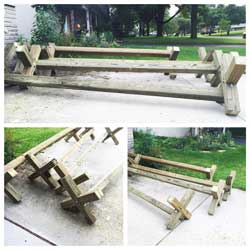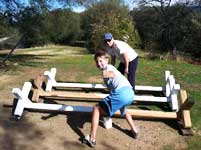

|
In this time of COVID-19 many of us are staying home. What to do? Now might be a good time to build those new cavaletti you have been thinking about. Here are your DIY simple FREE plans. It has come to my attention that there are some sites on the net that are using this cavaletti design and are charging up to $100.00 each for the plans. This page was originally put up in 1997 to show how easy building cavaletti could be. I offer this design to you for FREE as a service to the equestrian community. If you do reprint this in any other publication, please do me the favor of letting people know that you got it from the Texas Horseman's Directory at http://www.texashorsemansdirectory.com/thdcav.html. If you have any problems downloading this page and the attached diagram, please let me know. Olva Stewart Pharo, email: directory@texhorseman.com Let me know how your cavaletti worked out. Send me your pictures and I will post them here and on FACEBOOK. |
|
Whether you show English or Western or just train for fun, cavaletti can be a valuable training tool. The cavaletti is simply a pole set on 2 "x"s that give you three (3) training heights: 7", 12" and 17" for gymnastics. Four cavaletti set in a line at the lowest level can improve a horse's trot; set at the highest height they can make a small bounce jump. |

|
Cavaletti can be an integral part of your training equipment. it is easy to make your own. You will need the following supplies and tools to make one cavaletti:
• 2 - 4" x 4" x 8' treated wood posts • 2 - 4" long x 1/2" diameter steel carriage bolts with nuts and washers • 2 - 8" long x 1/2" diameter steel carriage bolts with nuts and washers • Saw - hand saw or power circular saw • Power drill with 1/2" wood drill bit • Wood chisel • Rubber mallet • Pencil, ruler and square for measuring The first step is to cut one of the 4" x 4" x 8' posts into four (4) equal sections of two (2) feet (24 inches) each. Find and mark the center of each 24" piece (Fig. 1). Take one marked 24" piece and place a second on top of it at right angles, matching the center marks. With a pencil mark off the width of one piece on the other (Fig. 1). (If you measure the true width of a 4" x 4" post it is usually 3-3/4".) Using your saw, cut half way through each post at the marks for the width of the second post (Fig. 2). (Based on a 3-3/4" post the cut should be 1-7/8" from the centerline and 1-7/8" deep.) Next, using your wood chisel and rubber mallet, take out the wood between the two cuts making a notch (Fig. 3). Do this on all four 24" pieces. ** Put together two (2) notched sections at right angles (Fig. 3). It may take a few wacks with your rubber mallet to get them to fit properly. Now, find the center of the "X" you have made and using your drill with a 1/2" wood drill bit, drill through both sections (Fig. 4). Run the 4" carriage bolt through this hole and tighten securely with a washer and a nut. This makes your cavaletti support secure. Do the same with the other two (2) sections. Now you have two "X"s that will stand up pn their own. Take the remaining uncut 4" x 4" x 8' post. Measure the width of the post (3-3/4"). Using that width, measure from each end of the post and draw a line. Find the center of that line and mark it with your pencil (Fig.5). Using your power drill with the 1/2" wood drill bit, drill a hole where the two (2) lines intersect (Fig. 5). Do that on each end of the 8' post, same side, of course. Then set up the "X"s and place the 8' post with the ends resting in the arms of the "X"s. You want the end of the 8' post to be flush with the sides of the arms of the "X". Using a pencil mark where the center of the hole through the 8' post comes out on one arm of the"X". remove the post. Using your power drill and your 1/2" wood drill bit, drill a hole through the arm of the "X" at your pencil mark. Do that on the other. Next, run the 8" carriage bolts through the holes in each end of the 8' post and then through the holes in the arms of the "X"s (Fig. 6) and secure with a washer and a nut. Now, you have one sturdy cavaletti that will not fall apart the first time your horse hits it. And if you used properly treated lumber (I recommend cedar), it should last for years to come out in the sun, the wind and rain. If you have any questions about this construction contact Olva Pharo at directory@texhorseman.com **Hint from a user: if you don't have the tools to create the notch use 2x4's instead of 4x4 landscape timbers, and cut two pieces shorter to create the notch. The 2x4x8 were nailed together from both sides to form 4x4's. --- from Joan in Ontario Places you will find this "How-To" on the Net: • The Chronicle of the Horse, credited • HorseAdvice.com, credited • HorseForum.com, credited • eHow, referenced Copyrighted by Olva Stewart Pharo dba Calaveras County Equestrian Management & Promotional Services, 1994. Originally published in THE HORSE SHEET, 1984; HORSEMAN'S HANDBOOK, 1987; TEXAS HORSEMAN'S DIRECTORY, 1989, 1991, 1992 - 2020. |
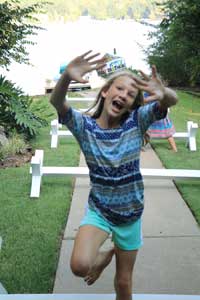 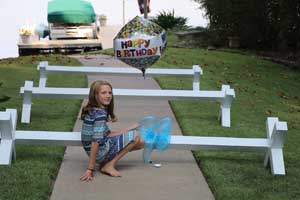 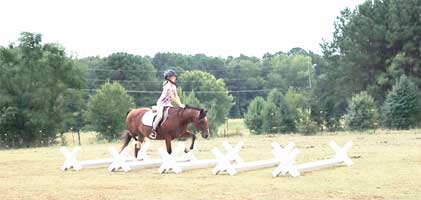 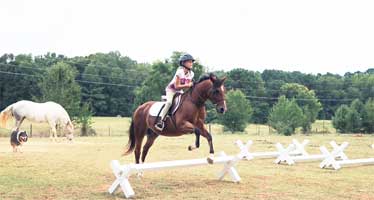 |
